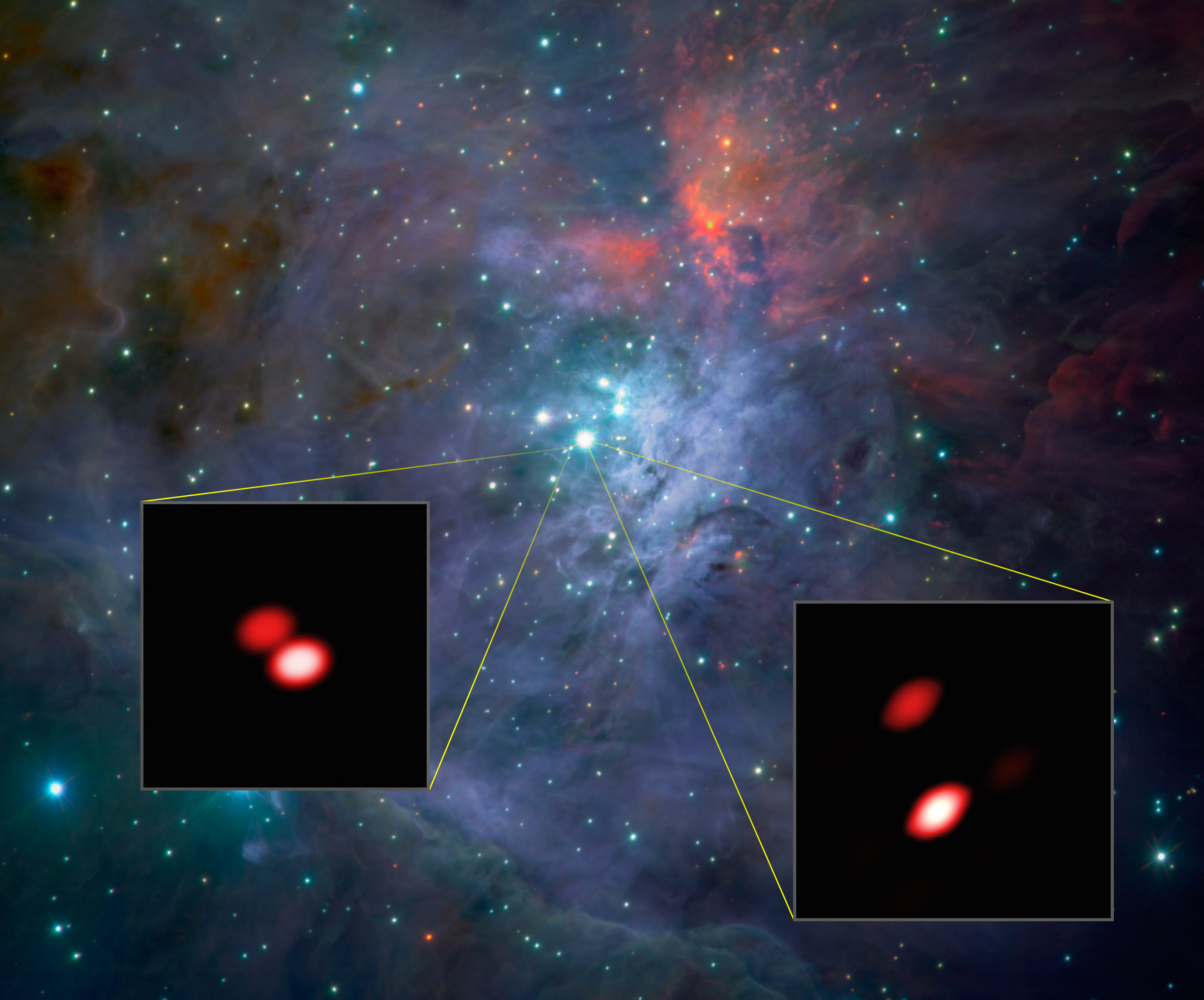Theta1 Orionis C on:
[Wikipedia]
[Google]
[Amazon]
 Theta1 Orionis C (θ1 Orionis C) is a member of the Trapezium
Theta1 Orionis C (θ1 Orionis C) is a member of the Trapezium
 Theta1 Orionis C (θ1 Orionis C) is a member of the Trapezium
Theta1 Orionis C (θ1 Orionis C) is a member of the Trapezium open cluster
An open cluster is a type of star cluster made of tens to a few thousand stars that were formed from the same giant molecular cloud and have roughly the same age. More than 1,100 open clusters have been discovered within the Milky Way galaxy, and ...
that lies within the Orion Nebula
The Orion Nebula (also known as Messier 42, M42, or NGC 1976) is a diffuse nebula in the Milky Way situated south of Orion's Belt in the Orion (constellation), constellation of Orion, and is known as the middle "star" in the "sword" of Orion. It ...
. The star ''C'' is the most massive of the four bright stars at the heart of the cluster. It is an O class blue main sequence star with a B-type main sequence
In astronomy, the main sequence is a classification of stars which appear on plots of stellar color index, color versus absolute magnitude, brightness as a continuous and distinctive band. Stars on this band are known as main-sequence stars or d ...
companion. Its high luminosity and large distance (about 1,500 light year
A light-year, alternatively spelled light year (ly or lyr), is a unit of length used to express astronomical distance, astronomical distances and is equal to exactly , which is approximately 9.46 trillion km or 5.88 trillion mi. As defined by t ...
s) give it an apparent visible magnitude of 5.1.
Theta1 Orionis consists of multiple components, primarily the four stars of the Trapezium cluster, all within one arc-minute of each other. Theta2 Orionis is a more distant grouping of three main stars plus several fainter companions, 1-2 arc-minutes from Theta1.
Theta1 C is itself a binary of two massive stars, C1 and C2, plus a very close fainter companion apparently escaping the system.
Theta1 Orionis C1 is responsible for generating most of the ultraviolet
Ultraviolet radiation, also known as simply UV, is electromagnetic radiation of wavelengths of 10–400 nanometers, shorter than that of visible light, but longer than X-rays. UV radiation is present in sunlight and constitutes about 10% of ...
light that is slowly ionizing (and perhaps photoevaporating) the Orion Nebula. This UV light is also the primary cause of the glow that illuminates the Orion Nebula. The star emits a powerful stellar wind
A stellar wind is a flow of gas ejected from the stellar atmosphere, upper atmosphere of a star. It is distinguished from the bipolar outflows characteristic of young stars by being less collimated, although stellar winds are not generally spheri ...
that is a hundred thousand times stronger than the Sun
The Sun is the star at the centre of the Solar System. It is a massive, nearly perfect sphere of hot plasma, heated to incandescence by nuclear fusion reactions in its core, radiating the energy from its surface mainly as visible light a ...
's, and the outpouring gas moves at 1,000 km/s.
The primary has a strong dipolar magnetic field
A magnetic field (sometimes called B-field) is a physical field that describes the magnetic influence on moving electric charges, electric currents, and magnetic materials. A moving charge in a magnetic field experiences a force perpendicular ...
with an intensity of . The field is inclined at an angle of to the rotation axis. Detected in 2002, this was the first O-type star found to have a magnetic field, and is most likely a fossil field. This field is confining the motion of the strong stellar wind, which should reduce the mass loss rate by 80%.
References
{{Stars of Orion Orionis, Theta1, C Orionis, 41, C Binary stars O-type main-sequence stars Orion (constellation) B-type main-sequence stars 0370221895
Events January
* January 5 – Dreyfus affair: French officer Alfred Dreyfus is stripped of his army rank and sentenced to life imprisonment on Devil's Island (off French Guiana) on what is much later admitted to be a false charge of tr ...
Durchmusterung objects
026221